radiator cap CHRYSLER 300 2013 2.G Owners Manual
[x] Cancel search | Manufacturer: CHRYSLER, Model Year: 2013, Model line: 300, Model: CHRYSLER 300 2013 2.GPages: 592, PDF Size: 4.48 MB
Page 473 of 592
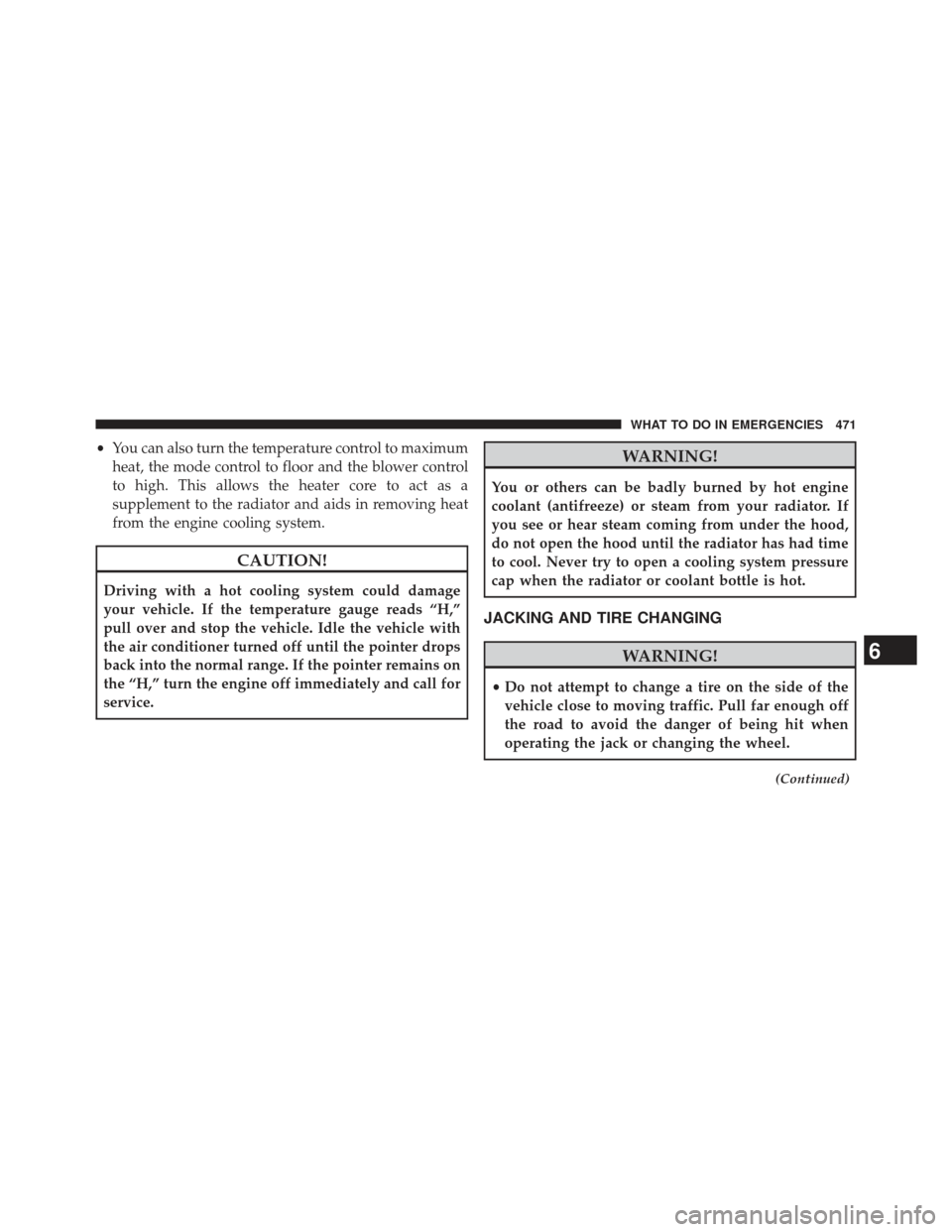
•You can also turn the temperature control to maximum
heat, the mode control to floor and the blower control
to high. This allows the heater core to act as a
supplement to the radiator and aids in removing heat
from the engine cooling system.
CAUTION!
Driving with a hot cooling system could damage
your vehicle. If the temperature gauge reads “H,”
pull over and stop the vehicle. Idle the vehicle with
the air conditioner turned off until the pointer drops
back into the normal range. If the pointer remains on
the “H,” turn the engine off immediately and call for
service.
WARNING!
You or others can be badly burned by hot engine
coolant (antifreeze) or steam from your radiator. If
you see or hear steam coming from under the hood,
do not open the hood until the radiator has had time
to cool. Never try to open a cooling system pressure
cap when the radiator or coolant bottle is hot.
JACKING AND TIRE CHANGING
WARNING!
• Do not attempt to change a tire on the side of the
vehicle close to moving traffic. Pull far enough off
the road to avoid the danger of being hit when
operating the jack or changing the wheel.
(Continued)
6
WHAT TO DO IN EMERGENCIES 471
Page 516 of 592
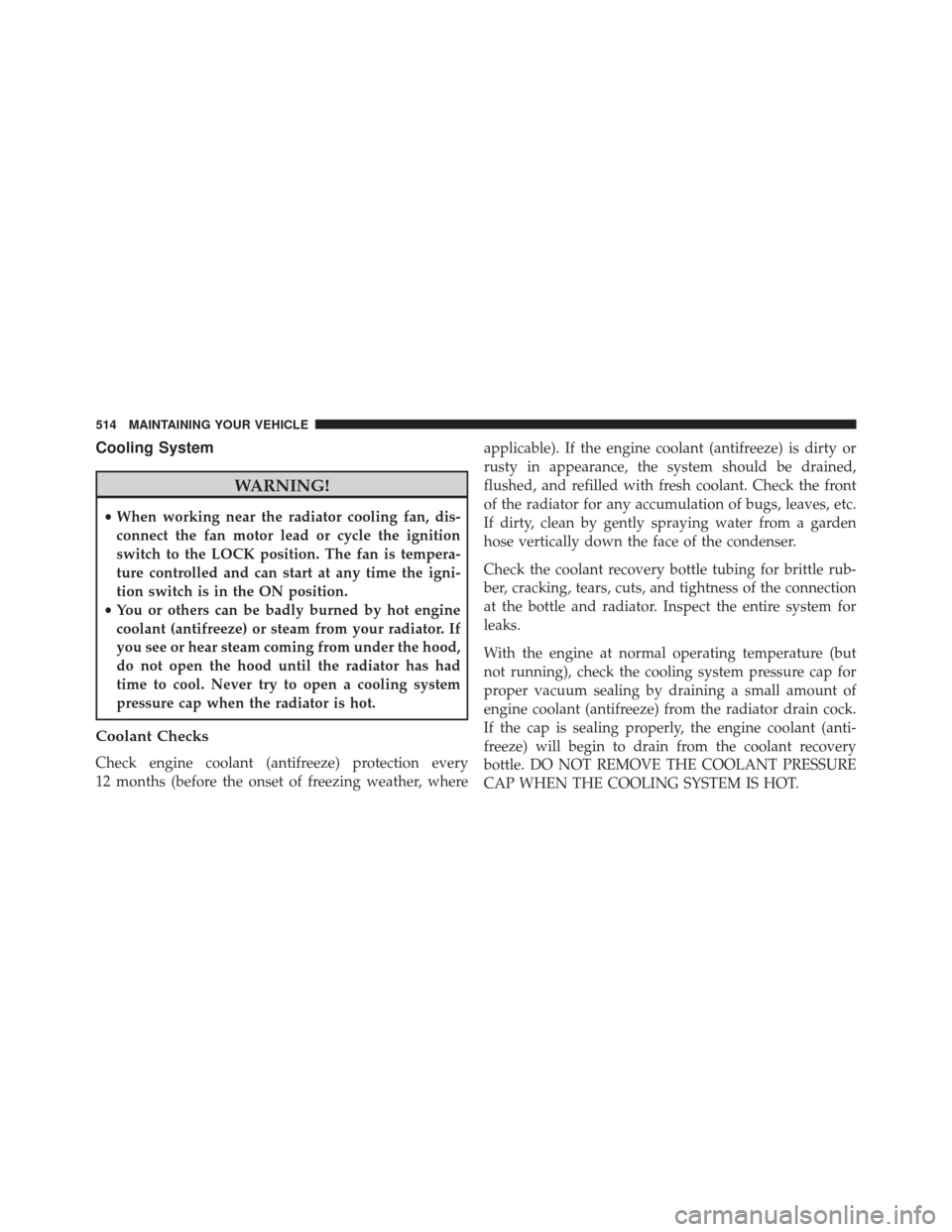
Cooling System
WARNING!
•When working near the radiator cooling fan, dis-
connect the fan motor lead or cycle the ignition
switch to the LOCK position. The fan is tempera-
ture controlled and can start at any time the igni-
tion switch is in the ON position.
• You or others can be badly burned by hot engine
coolant (antifreeze) or steam from your radiator. If
you see or hear steam coming from under the hood,
do not open the hood until the radiator has had
time to cool. Never try to open a cooling system
pressure cap when the radiator is hot.
Coolant Checks
Check engine coolant (antifreeze) protection every
12 months (before the onset of freezing weather, where applicable). If the engine coolant (antifreeze) is dirty or
rusty in appearance, the system should be drained,
flushed, and refilled with fresh coolant. Check the front
of the radiator for any accumulation of bugs, leaves, etc.
If dirty, clean by gently spraying water from a garden
hose vertically down the face of the condenser.
Check the coolant recovery bottle tubing for brittle rub-
ber, cracking, tears, cuts, and tightness of the connection
at the bottle and radiator. Inspect the entire system for
leaks.
With the engine at normal operating temperature (but
not running), check the cooling system pressure cap for
proper vacuum sealing by draining a small amount of
engine coolant (antifreeze) from the radiator drain cock.
If the cap is sealing properly, the engine coolant (anti-
freeze) will begin to drain from the coolant recovery
bottle. DO NOT REMOVE THE COOLANT PRESSURE
CAP WHEN THE COOLING SYSTEM IS HOT.
514 MAINTAINING YOUR VEHICLE
Page 519 of 592
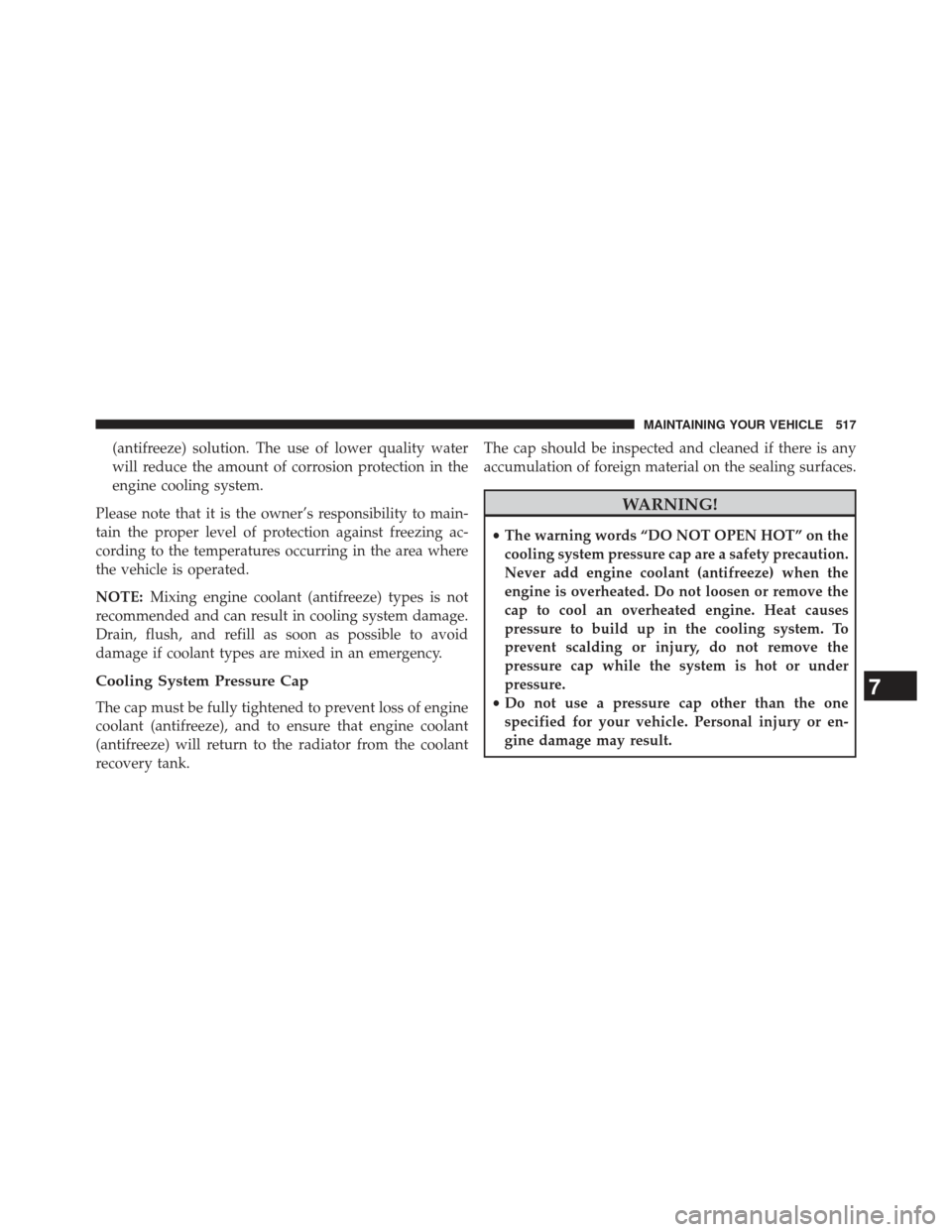
(antifreeze) solution. The use of lower quality water
will reduce the amount of corrosion protection in the
engine cooling system.
Please note that it is the owner’s responsibility to main-
tain the proper level of protection against freezing ac-
cording to the temperatures occurring in the area where
the vehicle is operated.
NOTE: Mixing engine coolant (antifreeze) types is not
recommended and can result in cooling system damage.
Drain, flush, and refill as soon as possible to avoid
damage if coolant types are mixed in an emergency.
Cooling System Pressure Cap
The cap must be fully tightened to prevent loss of engine
coolant (antifreeze), and to ensure that engine coolant
(antifreeze) will return to the radiator from the coolant
recovery tank. The cap should be inspected and cleaned if there is any
accumulation of foreign material on the sealing surfaces.
WARNING!
•
The warning words “DO NOT OPEN HOT” on the
cooling system pressure cap are a safety precaution.
Never add engine coolant (antifreeze) when the
engine is overheated. Do not loosen or remove the
cap to cool an overheated engine. Heat causes
pressure to build up in the cooling system. To
prevent scalding or injury, do not remove the
pressure cap while the system is hot or under
pressure.
• Do not use a pressure cap other than the one
specified for your vehicle. Personal injury or en-
gine damage may result.
7
MAINTAINING YOUR VEHICLE 517
Page 520 of 592
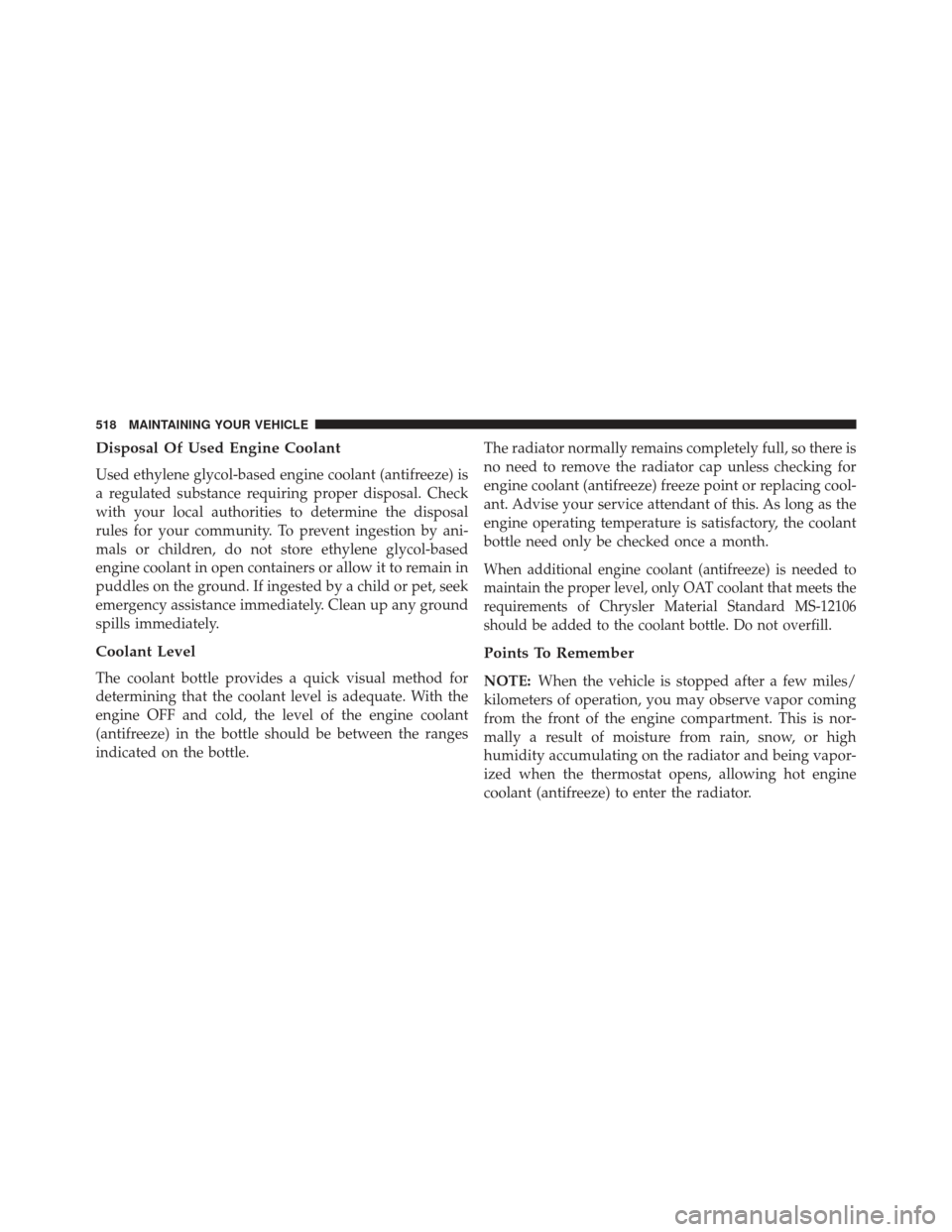
Disposal Of Used Engine Coolant
Used ethylene glycol-based engine coolant (antifreeze) is
a regulated substance requiring proper disposal. Check
with your local authorities to determine the disposal
rules for your community. To prevent ingestion by ani-
mals or children, do not store ethylene glycol-based
engine coolant in open containers or allow it to remain in
puddles on the ground. If ingested by a child or pet, seek
emergency assistance immediately. Clean up any ground
spills immediately.
Coolant Level
The coolant bottle provides a quick visual method for
determining that the coolant level is adequate. With the
engine OFF and cold, the level of the engine coolant
(antifreeze) in the bottle should be between the ranges
indicated on the bottle.The radiator normally remains completely full, so there is
no need to remove the radiator cap unless checking for
engine coolant (antifreeze) freeze point or replacing cool-
ant. Advise your service attendant of this. As long as the
engine operating temperature is satisfactory, the coolant
bottle need only be checked once a month.
When additional engine coolant (antifreeze) is needed to
maintain the proper level, only OAT coolant that meets the
requirements of Chrysler Material Standard MS-12106
should be added to the coolant bottle. Do not overfill.
Points To Remember
NOTE:
When the vehicle is stopped after a few miles/
kilometers of operation, you may observe vapor coming
from the front of the engine compartment. This is nor-
mally a result of moisture from rain, snow, or high
humidity accumulating on the radiator and being vapor-
ized when the thermostat opens, allowing hot engine
coolant (antifreeze) to enter the radiator.
518 MAINTAINING YOUR VEHICLE
Page 574 of 592
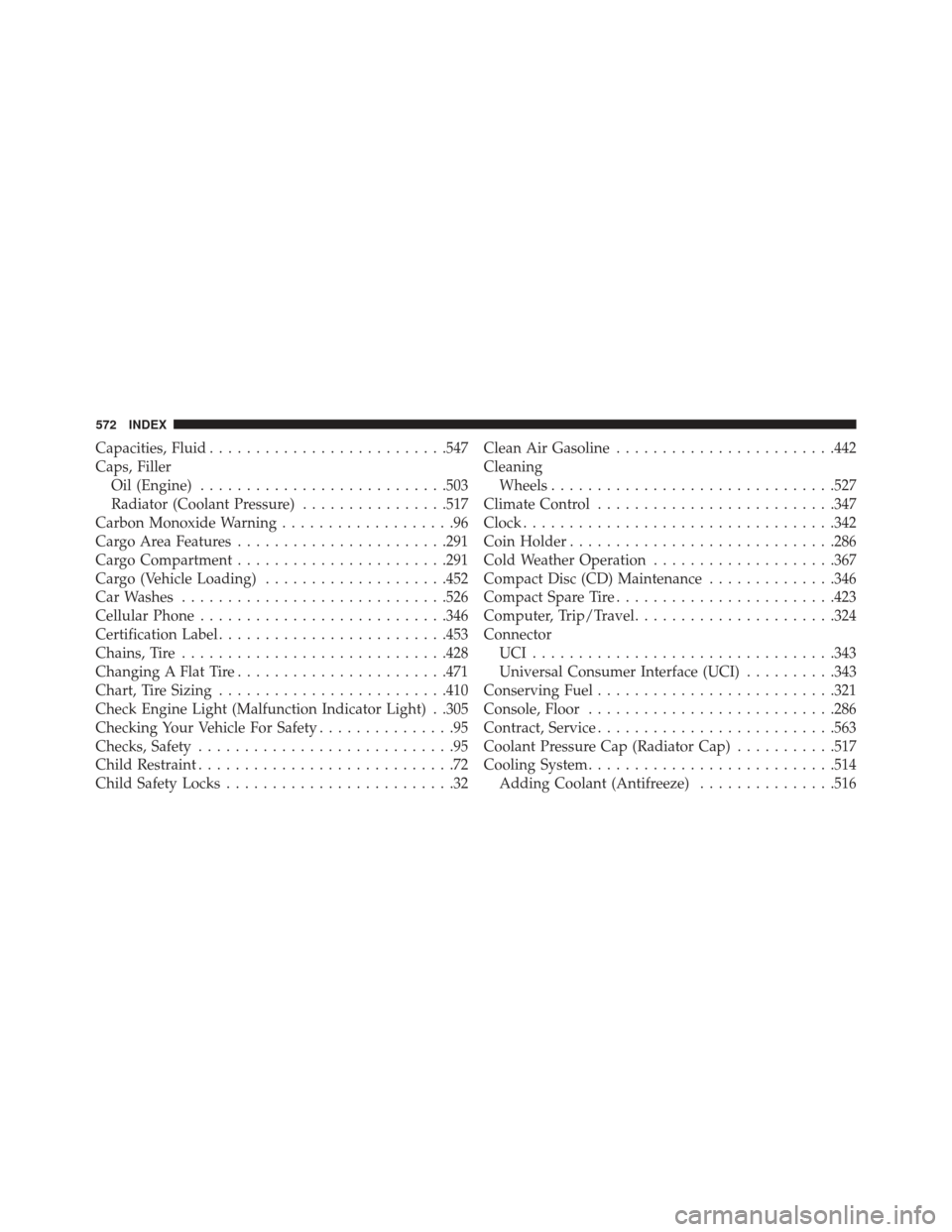
Capacities, Fluid......................... .547
Caps, Filler Oil (Engine) .......................... .503
Radiator (Coolant Pressure) ................517
Carbon Monoxide Warning ...................96
Cargo Area Features ...................... .291
Cargo Compartment ...................... .291
Cargo (Vehicle Loading) ....................452
Car Washes ............................ .526
Cellular Phone .......................... .346
Certification Label ........................ .453
Chains, Tire ............................ .428
Changing A Flat Tire ...................... .471
Chart, Tire Sizing ........................ .410
Check Engine Light (Malfunction Indicator Light) . .305
Checking Your Vehicle For Safety ...............95
Checks, Safety ............................95
Child Restraint ............................72
Child Safety Locks .........................32 Clean Air Gasoline
....................... .442
Cleaning Wheels .............................. .527
Climate Control ......................... .347
Clock ................................. .342
Coin Holder ............................ .286
Cold Weather Operation ....................367
Compact Disc (CD) Maintenance ..............346
Compact Spare Tire ....................... .423
Computer, Trip/Travel ..................... .324
Connector UCI................................ .343
Universal Consumer Interface (UCI) ..........343
Conserving Fuel ......................... .321
Console, Floor .......................... .286
Contract, Service ......................... .563
Coolant Pressure Cap (Radiator Cap) ...........517
Cooling System .......................... .514
Adding Coolant (Antifreeze) ...............516
572 INDEX
Page 575 of 592
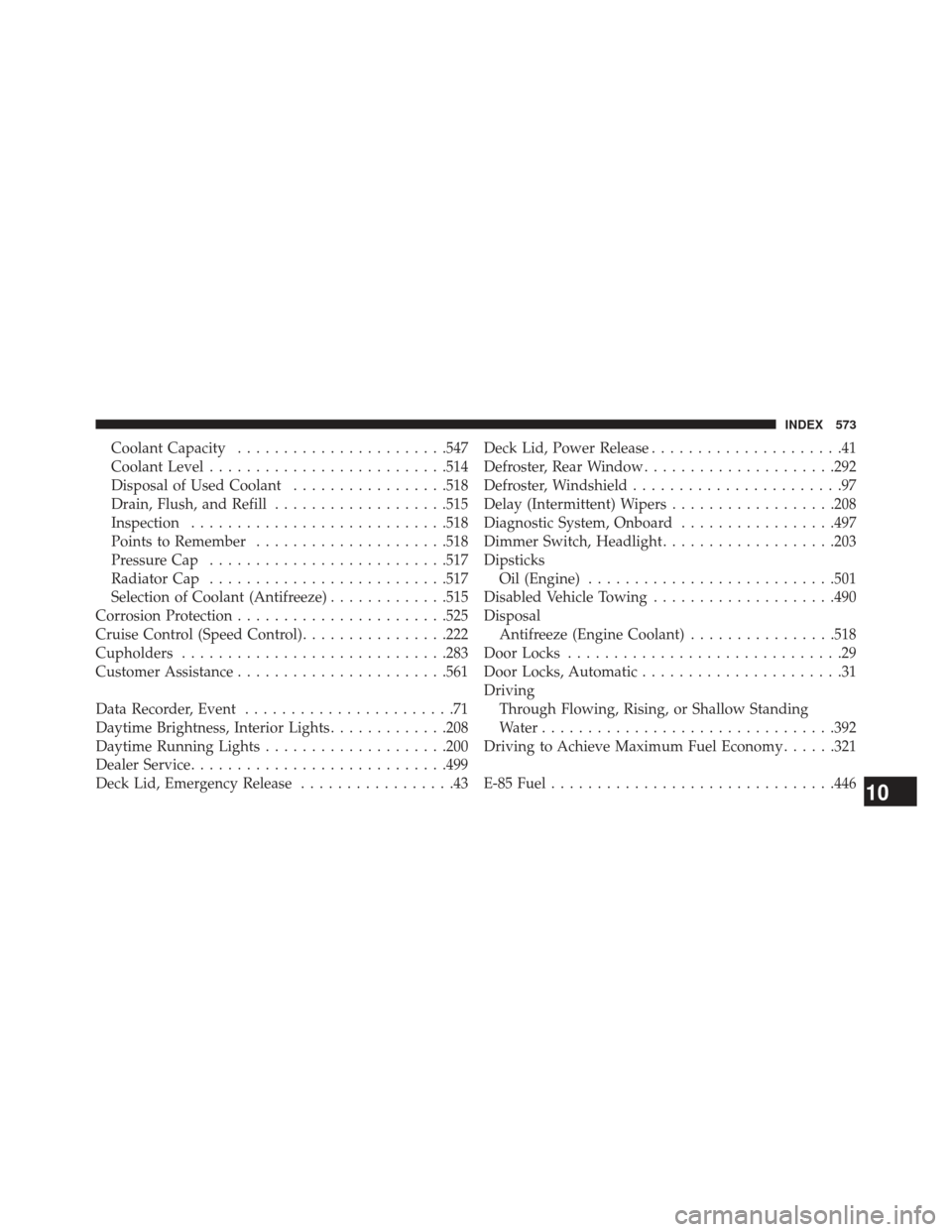
Coolant Capacity...................... .547
Coolant Level ......................... .514
Disposal of Used Coolant .................518
Drain, Flush, and Refill ...................515
Inspection ........................... .518
Points to Remember .....................518
Pressure Cap ......................... .517
Radiator Cap ......................... .517
Selection of Coolant (Antifreeze) .............515
Corrosion Protection ...................... .525
Cruise Control (Speed Control) ................222
Cupholders ............................ .283
Customer Assistance ...................... .561
Data Recorder, Event .......................71
Daytime Brightness, Interior Lights .............208
Daytime Running Lights ....................200
Dealer Service ........................... .499
Deck Lid, Emergency Release .................43Deck Lid, Power Release
.....................41
Defroster, Rear Window .....................292
Defroster, Windshield .......................97
Delay (Intermittent) Wipers ..................208
Diagnostic System, Onboard .................497
Dimmer Switch, Headlight ...................203
Dipsticks Oil (Engine) .......................... .501
Disabled Vehicle Towing ....................490
Disposal Antifreeze (Engine Coolant) ................518
Door Locks ..............................29
Door Locks, Automatic ......................31
Driving Through Flowing, Rising, or Shallow Standing
Water ............................... .392
Driving to Achieve Maximum Fuel Economy ......321
E-85 Fuel .............................. .446
10
INDEX 573
Page 584 of 592
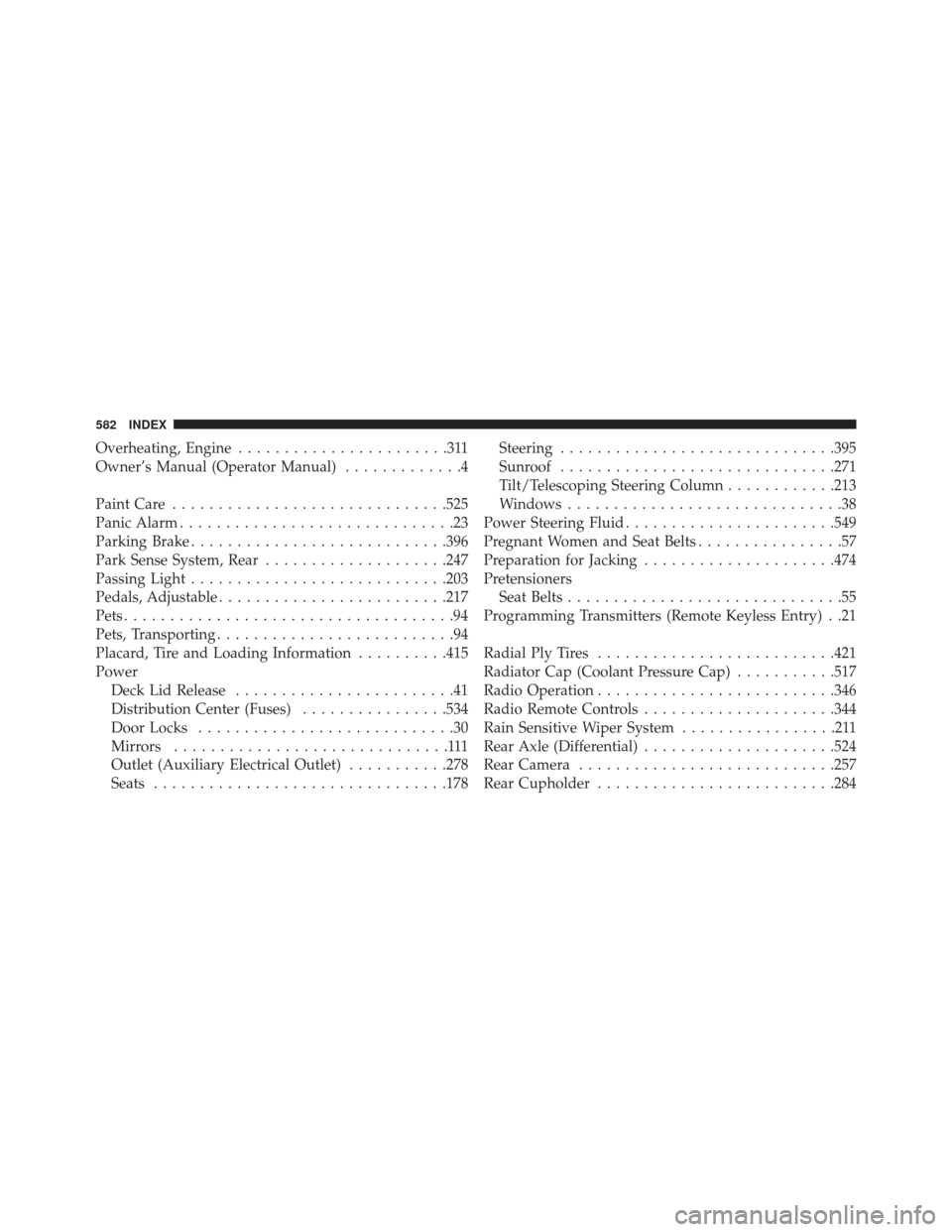
Overheating, Engine.......................311
Owner’s Manual (Operator Manual) .............4
Paint Care ............................. .525
Panic Alarm ..............................23
Parking Brake ........................... .396
Park Sense System, Rear ....................247
Passing Light ........................... .203
Pedals, Adjustable ........................ .217
Pets ....................................94
Pets, Transporting ..........................94
Placard, Tire and Loading Information ..........415
Power Deck Lid Release ........................41
Distribution Center (Fuses) ................534
Door Locks ............................30
Mirrors ..............................111
Outlet (Auxiliary Electrical Outlet) ...........278
Seats ............................... .178Steering
............................. .395
Sunroof ............................. .271
Tilt/Telescoping Steering Column ............213
Windows ..............................38
Power Steering Fluid ...................... .549
Pregnant Women and Seat Belts ................57
Preparation for Jacking .....................474
Pretensioners Seat Belts ..............................55
Programming Transmitters (Remote Keyless Entry) . .21
Radial Ply Tires ......................... .421
Radiator Cap (Coolant Pressure Cap) ...........517
Radio Operation ......................... .346
Radio Remote Controls .....................344
Rain Sensitive Wiper System .................211
Rear Axle (Differential) .....................524
Rear Camera ........................... .257
Rear Cupholder ......................... .284
582 INDEX